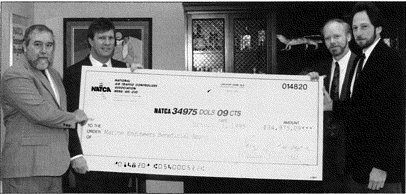
NATCA30: NATCA Breaks Away From MEBA
During NATCA’s early years, organizers John Thornton and Howie Barte found funding for the controllers’ organizing efforts after initial support and money from the American Federation of Government Employees (AFGE) was exhausted by late 1985. In October 1985, Marine Engineers Beneficial Association President Gene DeFries called Barte to say MEBA would fund them. While this relationship would define the organization for the rest of the 1980s, the Union was ready for a change by the 1990s.
NATCA’s finances had greatly improved by the mid-90s, eliminating its need to continue borrowing money from MEBA. NATCA President Barry Krasner and Executive Vice President Mike McNally presented MEBA with their final loan payment in Oct. 1995. That final payment was the last of the nearly $2 million dollars NATCA had owed to MEBA. By negotiating lower interest rates with MEBA starting in the early 90s, NATCA leadership saved the Union about $982,000 in interest payments and accelerated the repayment plan by ten years.
 |
| Krasner (far right) and McNally (second from right) present NATCA’s final loan payment of $34,975.09 to MEBA representatives (left). |
While the manpower, political contacts, and financial backing MEBA provided initially allowed NATCA to thrive, such support became less important as the Union gained financial independence. NATCA’s members were frustrated by the affiliation, as MEBA’s membership suffered because of financial problems and fallout from a racketeering trial. In their capacity as a MEBA affiliate, NATCA could not submit resolutions at AFL-CIO (American Federation of Labor and Congress of Industrial Organizations) conventions without MEBA’s permission. NATCA continued to pay 7.5 percent of its members’ dues to MEBA, and NATCA’s leadership didn’t believe the Union was getting the same return as when it affiliated with MEBA.
These issues pushed NATCA to seek direct affiliation with the AFL-CIO. At its Sept. 1996 convention in Pittsburgh, NATCA delegates voted to allow NATCA to align with another union.
In February 1997, Krasner and outside counsel William Osborne met one last time with MEBA to fulfill the requirements of their affiliation agreement. The meeting ended poorly after Shandrowsky announced that MEBA had unilaterally modified its agreement with NATCA to make disaffiliation nearly impossible. The modification ensured that NATCA would forfeit its assets in the event it broke away. Krasner replied that NATCA intended to do so with or without MEBA’s approval. After the meeting, Osborne filed a court injunction to prevent MEBA from retaliating by putting the controllers’ Union in trusteeship and seizing its assets. MEBA sent NATCA a letter opposing disaffiliation and threatening legal action. The Union then filed a lawsuit against MEBA in May 1997, seeking the right to disaffiliate.
Despite the protections afforded by the injunction, Krasner hired 24-hour armed guards to protect the national office in case MEBA decided to launch a raid. He also told employees to take home critical files, explaining that the Union must keep running at all costs. About $3 million was shifted to different accounts to make it harder for MEBA to find.
“Walking around my last days in office with armed guards and money spread out across the country was kind of spooky,” Krasner says.
During this time, AFL-CIO general counsel Jon Hiatt advised Osborne that it would not be inclined to grant NATCA direct affiliation if the union broke away from MEBA. At Krasner’s direction, Osborne replied that NATCA intended to achieve independence and it believed direct AFL-CIO affiliation was best for both organizations, adding that the Union was prepared to live with the outcome if turned down.
The tense period passed without incident and as part of a court-ordered settlement in June 1997, NATCA asked its members to vote on the issue of affiliation. On Aug. 13, 1997, out of the 6,044 ballots cast, 99 percent favored breaking away from MEBA. The effective date became May 30, 1997, based on an out-of-court settlement with MEBA.
A now independent NATCA faced the formidable task of persuading the AFL-CIO, which represented some 13 million workers, to accept a union with less than 11,000 members as a direct affiliate.
Since the merger of the American Federation of Labor and Congress of Industrial Organizations in 1955, only 20 or so unions had achieved that honor because AFL-CIO policy discouraged direct affiliations.
A three-member special committee on AFL-CIO national charters expressed concern about the PATCO strike and its effect on organized labor. They wanted assurances from NATCA’s new President McNally (who had been elected in 1997), Executive Vice President Randy Schwitz, and Osborne that NATCA did not intend to repeat its history. At the same time, the committee was impressed by what NATCA had achieved during its first decade.
The panel credited NATCA and MEBA with helping to ensure that “the air traffic controllers’ legacy has not been forgotten, that it remains a symbol warning the labor movement against complacency and against forgetting that an attack on one union is an attack on all.”
A month after NATCA appeared before the committee to present its case, the AFL-CIO Executive Council agreed. On Mar 20, 1998, the AFL-CIO Executive Council voted unanimously to accept NATCA as a direct affiliate. At a meeting later that spring in Las Vegas, the AFL-CIO presented NATCA with its cherished independent charter.

